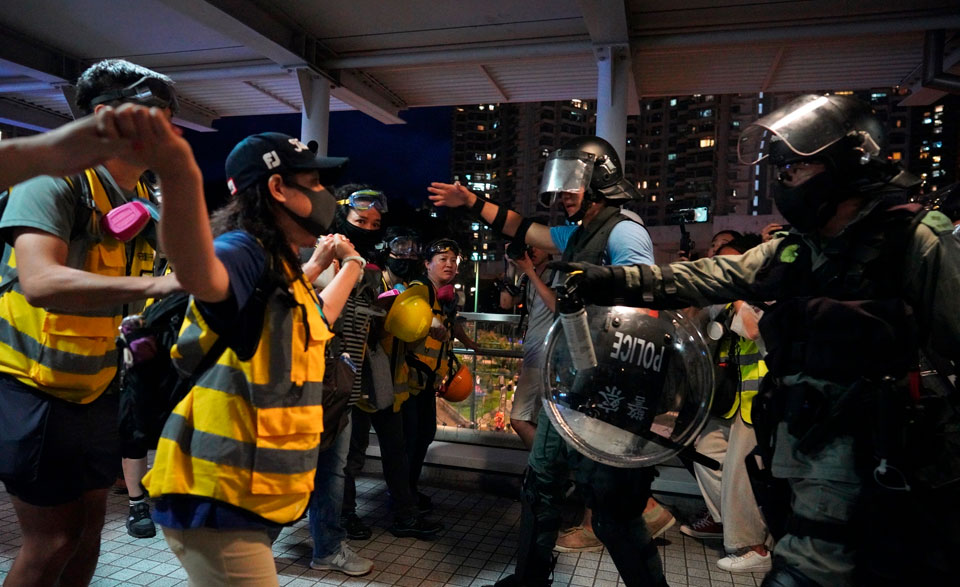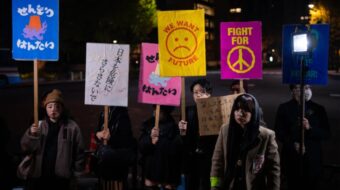
The large-scale protests gripping Hong Kong the past few months, which have included violent confrontations with authorities, strikes, and student boycotts, show few signs of abating.
The protests, including the June 16 and Aug. 18 demonstrations that drew 1.7 million participants, were sparked by the introduction of an Extradition Law into the Hong Kong Legislative Council. The proposed measure would have allowed Hong Kong authorities to detain and transfer out people wanted for crimes in Taiwan, Macau, or mainland China to stand trial in those jurisdictions.
The bill was put forward after a Hong Kong man murdered his girlfriend while visiting Taiwan. Because there exists no treaty for extradition between the governments of the two places, there was no way to put the man on trial for his crime, given that he had abruptly returned to Hong Kong before being discovered. The law’s opponents, however, have expressed fear it would be used by the Beijing government to pursue political charges against Hong Kong dissidents.

In the wake of the continuing protests, on Sept. 4, Carrie Lam, the Hong Kong Chief Executive, withdrew the bill. It remains to be seen what effect this will have since protesters are voicing additional demands beyond the original bill.
Chinese officials suspect U.S. and British imperialism are exploiting the mass discontent to provoke a “color revolution” in Hong Kong to separate it from China. The goal, as Beijing sees it, is also to spread unrest to the mainland and undermine China’s socialist system.
Given the history of U.S.-backed regime change and support for the “color revolutions,” this scenario is not hard to imagine. However, U.S. meddling can’t possibly fully explain the size, scope, and persistence of the demonstrations.
The causes of the protests are complex and involve democratic rights, national identity, a clash between China’s socialist system and the legacy of British colonialism (including the common law system and unfettered market economy), and deep dissatisfaction, anxiety, and anger over explosive social and class inequality.
Hong Kong identity
If history shapes identity, then Hong Kong identity has been shaped over a complicated history spanning two millennia.
The sparsely populated Hong Kong island became part of China during the Qin Dynasty, 220 BCE. For years, it served as a source of salt, pearls, and more and more as an international trading center. Maritime trade between China and European colonial powers began in the 1500s. The East India Tea Company started operations in 1711. Eventually, trade flourished in tea, porcelain, and silk.
Unable—or perhaps unwilling—to pay for tea in silver, the British began smuggling opium as a means of exchange. The Qing Dynasty sought to ban opium after the drug addicted millions and corrupted the administrative state. The first European-Chinese conflict, known as the Opium War, was the result. In 1841, a defeated China was forced to cede Hong Kong island to the British as part of the Treaty of Nanjing.
China was also forced to lease the adjacent Kowloon Peninsula (1860) to the British in perpetuity and the New Territories (1898) for 99 years. These areas also make up present-day Hong Kong.
Hong Kong became a crown colony of the British Empire and was occupied by the Japanese during World War II. After the war, Hong Kong reverted to the British, and following the establishment of socialism in mainland China in 1949, served as a significant trading and financial center, useful economically and diplomatically to both sides in the Cold War.
Britain was forced to transfer sovereignty of Hong Kong back to the now socialist-oriented People’s Republic of China (PRC) when the 99-year lease expired in 1997. Britain and the PRC negotiated a transition known as the Sino-British Joint Declaration, which resulted in the PRC designating Hong Kong as a “special administrative region” (HKSAR). As part of the 1984 agreement, China agreed to extend semi-autonomy to Hong Kong, including its economic and trade policies, as well as judicial, executive, and legislative powers for 50 years—up until 2047. And so was born “one country, two systems,” a contradiction which is at the heart of today’s conflict.
Since 1997, the Basic Law has governed Hong Kong. It outlines the rights and freedoms of residents, structure of government, electoral system, and property rights. Many of the Basic Law’s principles, including lack of direct elections, were carried over from the British colonial system.
Some of the protesters are calling for secession or independence from China. Understandably, China’s National People’s Congress can never agree with this demand. It would be like allowing Manhattan to secede from the U.S.

Having experienced the humiliation of colonial oppression, China will never again permit any dismemberment of its historically formed territory. Nor will it allow the current social upheaval to be used as a wedge to destabilize the Chinese system of socialism.
Changing status of Hong Kong
The Sino-British Joint Declaration reflected the geopolitical balance of forces and China’s developmental needs as they stood in the mid-1980s. China was embarking on its “opening up” economic reforms, and massive foreign capital investment was essential. Hong Kong was a conduit for that investment (and even more so after the events of Tiananmen Square in 1989). China had to guarantee stability for both Hong Kong and foreign capitalists by ensuring that the HKSAR remain a vital financial and trade center, a doorway connecting the country to the capitalist world economy.
In many respects, China and Hong Kong have been on two distinct and intersecting paths of development. Britain administered Hong Kong as a colony for 150 years, leaving an indelible imprint on its identity, lifestyle, and legal system, its social, political, and economic system, and its culture, language, and democratic sensibilities.
As a trading and financial center, Hong Kong became a city of immigrants. Waves of immigrants arrived after the 1949 Chinese Revolution, and again in the 1970s and 1980s following the economic reforms and opening up, including many who did not support China’s socialist revolution.
British and U.S. imperialism have continued to influence Hong Kong identity. Even though Hong Kong never experienced full democracy and universal suffrage under British colonialism, the promise of those ideals resonated.
The economic growth Hong Kong experienced in the 1980s and ’90s was related to China’s economic reforms and need for foreign capital. But times have changed. In 1997, Hong Kong’s gross domestic product was 27% of China’s GDP. It’s now 3% and declining. The world’s largest banks are now in China, and they are state-owned.
Shenzhen and other major Chinese cities have surpassed Hong Kong as finance and manufacturing centers. But the Hong Kong stock market is where many Chinese companies are listed, and it remains an essential (if somewhat less important) source of foreign capital.
Challenges to building a socialist democracy
China took the revolutionary path in 1949, to build what would eventually be called socialism “with Chinese characteristics.” Since the start of the economic reforms 40 years ago, China has undergone historically unprecedented economic, social, and political changes.

Born out of feudalism, the People’s Republic of China did not inherit a developed bourgeois democracy, freedom of the press or speech. A modern socialist economy and governing model, one based on its traditions and history, had to be and is being built practically overnight.
The “one country, two systems” model was always planned to eventually give way to the full integration of Hong Kong into China by 2047. In many ways, this process is also unprecedented in human history. As mainland China’s government increasingly asserted its sovereignty and authority, contradictions and clashes were bound to occur. It has now been 22 years since the British left Hong Kong—almost halfway through the planned 50-year lifespan of “one country, two systems.”
As for the extradition treaty, most countries have such laws. Hong Kong and China are one country, but Hong Kong still has no extradition laws with China, Macau, or Taiwan. The absence of an extradition law is a legacy of British colonialism and China’s isolation following the 1949 socialist revolution.
The proposed extradition bill was limited and under the authority of the Hong Kong judiciary. However, China’s suppression and censorship of political opposition fueled suspicion and unease among Hong Kongers. Many felt the Extradition Law would allow anyone, including those with political differences, to be extradited to the mainland. Likewise, those wealthy Chinese who committed financial crimes and fled to Hong Kong to escape prosecution are justifiably worried.
Deep social problems
While the Extradition Law triggered the explosion of protests, they reflect a tinder box of deeper underlying issues. While China’s GDP is expected to grow at a 6% rate in 2019, Hong Kong’s GDP is projected to grow by only 1 or 2%, sharpening problems.
These economic and social problems are a consequence of British colonialism. They have created social anxieties now being misdirected by some forces against the Chinese mainland and government.
According to Oxfam, Hong Kong is the most unequal of all developed economies in the world. The top five wealthiest Hong Kong capitalists rank in the top 100 globally.
Hong Kong is the second most expensive city in the world after London; 21% of Hong Kongers live below the poverty line, while another 20% live on the verge of poverty.
An oligarchy of real estate tycoons and the corporate elite dominates economic and social life in the city. The corruption that characterized relations between government and real estate moguls led to a longstanding housing crisis in Hong Kong. Residents continually pay more for housing, but end up with tinier and tinier apartments. As they frequently point out to visitors, to indicate the extreme density of housing, 70% of Hong Kongers live above the 15th floor.

Revenues from property sales are the primary revenue source for the Hong Kong government. Property values here are among the highest in the world. Even though wages have stagnated, property prices doubled between 2010 and 2018 and have risen 300% since 2003. Compared to its developed world peers, the Hong Kong government spends among the least on health care, education, housing, and other social programs.
Economist Andy Xie says the situation makes it “very difficult to see how young people can feel hope. They know they’ll never be able to afford a place, so they cannot start a family. How can they get ahead in life? Desperation, and really a deep sense of unhappiness, is driving this unrest.” According to Xie, “Hong Kong has been a pressure cooker for a long time.”
Roots of today’s protests
The extent and depth of support for the protests among ordinary Hong Kongers are not clear. Hong Kong is politically divided among various contending forces, including those who support China’s central government. Many residents, owners of small businesses, and financial and tourism companies, have felt offended by acts of violence and public destruction on the part of protesters.
Though organized initially around fears related to the extradition law proposal, the current protests are also connected to earlier movements resisting the authority of China’s central government, which have become more active as the end of semi-autonomy approaches. Longstanding demands for direct elections, universal suffrage, and economic justice have been added to the protest agenda.
A Hong Kong Occupy-type movement (also called localist) developed a decade ago during the global financial crisis in opposition to extreme wealth inequality, the power of Hong Kong oligarchs, rapid urban development, and environmental destruction. Many of the protests at that time reflected a rejection of capitalism.
Social movements emerged on the right and left in Hong Kong, a striking parallel to what occurred in the U.S. in response to the 2007-08 financial crisis. A right-wing populist movement that has become more visible is characterized by nativism, anti-China sentiments directed at the mainland, and even nostalgia for British colonialism. Other movements, however, including those calling for self-determination, embrace labor rights, gender equality, and the rights of minorities.
What became known as the Umbrella Movement (named for demonstrators’ use of umbrellas to protect against police tear gas) erupted in 2014 in opposition to changes in electoral law passed by the Standing Committee of the National People’s Congress of the PRC. The changes called for two or three candidates for the chief executive of Hong Kong to be pre-approved by an election committee before going to the voters instead of general elections open to all parties and candidates. The protests extended for some 80 days and ended when the electoral reforms were scrapped by the Hong Kong Legislative Council.
The billionaire Jimmy Lai, publisher of the Apple Daily, is widely seen as a significant funder of the protests, both those of the past and today. Apple Daily acted as a voice for the demonstrations and helped spread vicious anti-immigrant hatred, including characterizing mainland Chinese migration as a “locust infestation.” Lai has a financial stake in the matter: His media empire has lost massive amounts of money due to an advertising boycott ordered by Beijing over his support for previous anti-China protests.
After the Umbrella Movement ended, so-called “pro-democracy” organizations and leaders, including those backed by the U.S. National Endowment for Democracy (NED), were pushed aside by a younger generation of more militant activists. Some of these new social movements favoring independence from China and self-determination gained ground. Some are also receiving support from the NED.
Today’s protests and the future
Some of the social movements that emerged from the Umbrella Movement are leading the current demonstrations. The Hong Kong Civil Human Rights Front, consisting of about 80 organizations, initiated the protest on June 9 in response to the Extradition Law. But the demonstrations involve broader segments of Hong Kong society and don’t appear to have a single center.
They range from those demanding independence or secession, to those advocating social justice and support for China’s central government, to anarchists provoking violence. Some have strong right-wing populist and nativist currents tapping into a growing Hong Kong national identity.

It’s worth saying again: Hong Kongers never achieved full democratic rights, direct elections, and universal suffrage under British colonial rule. In the early 1990s, as the transfer in sovereignty approached, the British belatedly carried out some democratic reforms supported by China. But in 1994, Chris Patten, the last colonial governor, unilaterally and without consultation pushed through additional changes to cement Britain’s continuing influence.
Naturally, China reacted negatively. After the transfer of Hong Kong back to China in 1997, China disbanded the last Legislative Council elected under British colonialism. In 1998, Hong Kong held new elections under the Basic Law.
By any measure, it must be admitted that elections in Hong Kong today are limited. Voters choose half of the representatives to the Legislative Council through direct elections based on geographic districts. The other half are elected through associations from lists of approved candidates, mainly business and professionals. An Election Commission selects the Chief Executive.
Although multiple parties contest, there are still no direct elections, an objective of the Basic Law that, so far, remains unfulfilled.
Ultimately, the “one country, two systems” model reflects a clash of political philosophies. On the one hand, a new and evolving socialist democracy rooted in China’s history, finding its way to directly empower people’s governing with a single ruling party. On the other, a restricted democratic governing model shaped by British colonial occupation. Resolving these contradictions will be an ongoing challenge and at times, a painful process.










